4 ways to make game learning interesting
Agree, we all hate tutorials. Having established the game, we want to go directly to the action, rather than poking around in the menu, understanding the rules and controls. But you do not want it, but for each new game you need to learn new rules. In another way.
By and large, there are 3 types of gaming tutorials: non-interactive, interactive and passive. Let's take a look at each of them in turn.

Computer games are so multifaceted that instructions like "use arrows to move, and space to shoot" cannot be done here. Players need to explain, avoiding unduly rectilinear prompts, like “beware of sharp thorns”, how to interact with the outside world and overcome dangers.
In general, the tutorial I want to quickly get out of sight. The problem is that in the first few minutes the impression of the game is completely formed. In this regard, AAA-class games can afford more freedom, but developers of mobile and web applications should interest the player as early as possible, otherwise he will quickly jump off the hook. So, we face a difficult task - to create an exciting study without any burden, and even better - to make it part of the game.
')
Non-interactive training
Non-interactive gaming training is a relic of the past. Below is a screenshot from the game Infected, which we created with my team several years ago.
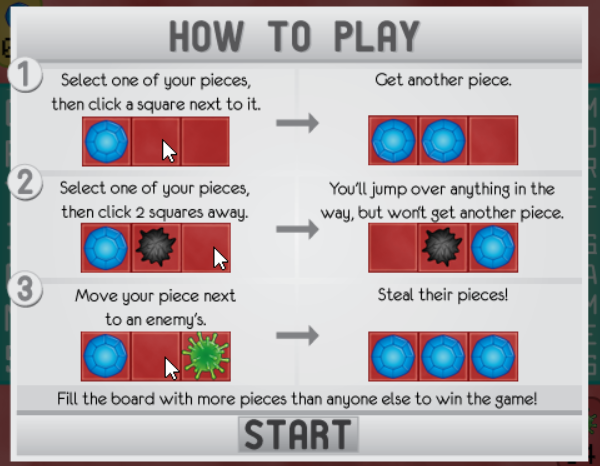
Training in the game Infected .
All training consists of a single picture. Looking back, I have to admit that we made a big mistake here. Seeing this screen, the players ran their eyes through the text and immediately pressed the "Start" button. As a result, most of them did not understand the rules.
According to the creator of the amazing game Plants vs. Zombies by George Fen , at any time of the game on the screen should be no more than eight words. This is because the majority of players cannot concentrate for a long time and are not ready to accept large amounts of information.
Non-interactive learning is not so hopeless, but almost always violates the eight-word rule. Its main disadvantage can be summarized as follows:
Too much information!
This is the most important rule for the design of gaming tutorials. The player must be well oriented in any situation. Seeing in front of him a list of two hundred combos and special attacks, he will remember only a couple of and will use them until the end of the game. Only if the training will be gradual, the player will be able to understand all the rules and master all the abilities.
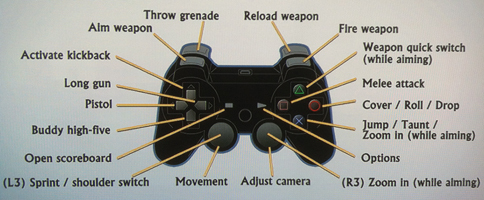
We have already talked about this in the context of the use of game achievements in learning. Forcing the player to pass the level with the basic weapon, we will not achieve anything. But the opportunity to achieve an achievement for the fulfillment of this condition can be an incentive to try out new tactics and strategies (especially for experienced players).
Similarly, you can use the game rating system with scoring stars or points - "Losers" easier to pass levels, and lovers to overcome difficulties earn more points. This allows hardcore players to pass the levels at 100%, and casual players can enjoy the game without any difficulties.
The learning process in the game Super Meat Boy lasts as much as 6 levels. At first, the player learns to move and jump. At the second level - jump, starting from the walls. On the third - to run. Having dealt with the controls, he meets new obstacles: rotating blades, unstable platforms and steps.
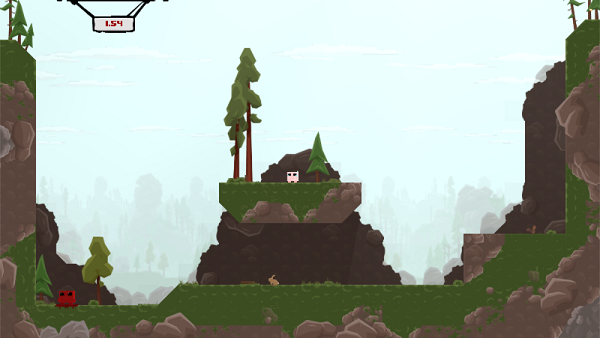
The first level of the game Super Meat Boy. First you need to learn to walk and jump.
Losing on the first level Super Meat Boy is almost impossible. This technique in game design is called the “newcomers cave” —the player must first pass safe training levels before reaching the place where he can die. Thus, you can safely get acquainted with the game mechanics, without being distracted by enemies or expiring time on the timer.
To some extent, the “newcomers cave” is present in the Infected game - you can lose at the first level, but for this you need to try hard. The player gets a big starting advantage (2 times more elements than the opponent), and besides, the level of artificial intelligence is at zero. At high levels, the computer performs the calculated steps, but at the first level its actions are completely random. This means that even if a player does not understand the rules at all, his chances of winning are very high. (Some still managed to lose, but in general the gaming experience was much better compared to the original version, when at the very first level, players were faced with advanced artificial intelligence.)
There are several ways to implement the “novice cave”, but the most effective is interactive training, in which the player can perform only certain actions necessary to win. So, you can understand the rules right in the game, without risking to lose in the first minutes.
Interactive learning
Meet the game mechanics is much more interesting in practice. Instead of explaining the rules in words, it is better to let the player act on his own.

The first steps in the game Highrise Heroes.
A screenshot from the Highrise Heroes game perfectly demonstrates how to engage players in the learning process. Than just to show a picture illustrating the process of making a word, it is better to force the player to do it on their own, so that he will probably become familiar Until a player completes this basic task, he will not be able to go to the next level.
The only drawback of such training is that for players who are already familiar with the game, the mandatory passage of the tutorial can be boring. Opportunity to miss training will help to avoid this, but note that even those who play for the first time will not fail to take advantage of it. According to the creator of the game Steambirds, Andy Moore, having made the training mandatory, he managed to increase the retention rate of players from 60% to 95%.
Background training
Background training immediately immerses the player in the gameplay. There is a “cave for beginners”, but you can get out of it much faster and immediately plunge into the thick of things.
Consider this example:
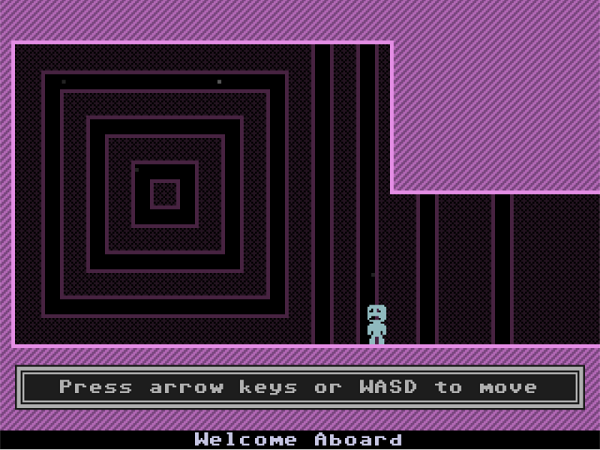
The initial location of the game VVVVVV, where the player can understand the management.
At the very beginning of the game VVVVVV, a tooltip appears on how to move left and right. After that, the player is left with nothing but to go to the next room, where he learns to jump over obstacles. At this training ends. In principle, both stages would fit in the same room, but their separation helps the player better assimilate the information.
There is a very thin line between background and interactive tutorials. The main difference is that you can easily skip background training, and it will just fade into the background.
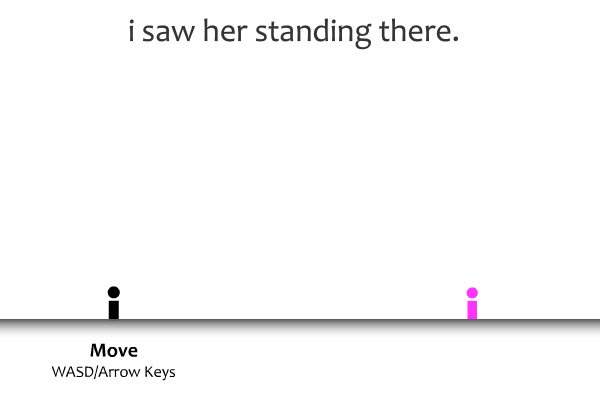
I saw her standing there - amazing flash game. Please note that you start playing even before the main menu appears.
We needed to use interactive or background training in Infected. It could be divided into 3 stages (movement, jumping and capturing elements of the opponent), and then it would be much easier for players to understand the gameplay. We understood this perfectly, but still decided not to bother with training and quickly finish the game.
Lack of learning
How to open the water? It is necessary to turn the handle of the crane to the right. How to tighten the nut? You need to turn the key clockwise. For these actions, no instructions are needed - we already understand their principle on an intuitive level. More precisely, we get this knowledge at an early age and consolidate it throughout life.
In games, everything is exactly the same. Experienced gamers subconsciously understand that you need to collect coins and earn points. But for beginners, this is not so obvious, so it is important for us to bring them up to date (although, even if you have never played platformers, you will understand that jumping into the fire is not the best idea).
The difference between “good” and “bad” should be clear from the first minutes, so that players do not have to learn from their mistakes, losing their lives. Shigeru Miyamoto once explained why coins are used in Mario:
"We have long thought about what any person would like to own, and could not think of anything better than money."
Plants and zombies in Plants vs. Zombies require no explanation. And it is so clear that zombies are moving slowly, and the plants are not moving at all. Instead of the hackneyed concept of “tower against soldiers”, the game offers an original idea, seasoned with an intuitive gameplay.
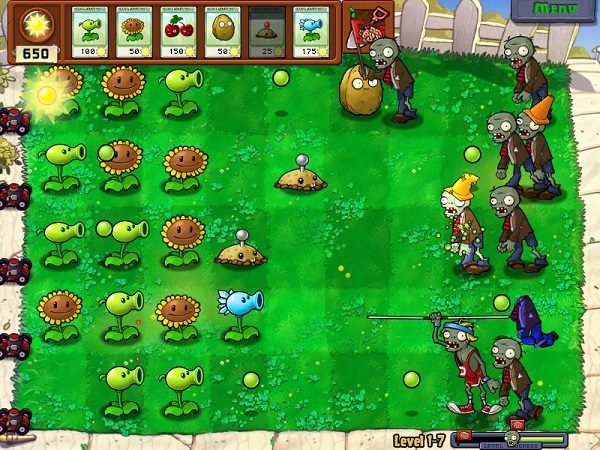
Agree, at first glance, it is clear what is happening on the screen.
Many players understand the general principles, so they do not need to explain everything. Let them figure it out on their own. If the player does not budge, give him a hint (“Move with the joystick”), but note that in most cases the players themselves are trying to execute the basic commands. Basic mechanics are usually universal, so it can be assumed that they are already familiar to the players, but at the same time changing them can be very dangerous.
Some new game designers believe that the rules are invented for wimps, and are often neglected by them. In the past, games in the RTS genre have suffered greatly from this misconception. Modern strategies use a fairly standardized control system (the left mouse button for selecting and the right one for moving or attacking), but in older games the control varied greatly - the left and right buttons performed different actions, and several commands could be attached to one button. Playing old strategies today can be very problematic, because we have become accustomed to a different management system.
We can say that Infected was saved by intuitive control. Even if a player misses training, when an element is selected, the cells are immediately highlighted, which you can resemble. Such visual highlighting hints that the player is doing everything right, and encourages independent research of game mechanics. In the initial versions, the backlight was absent, but later we made sure that this small graphic addition makes the gameplay much more accessible.
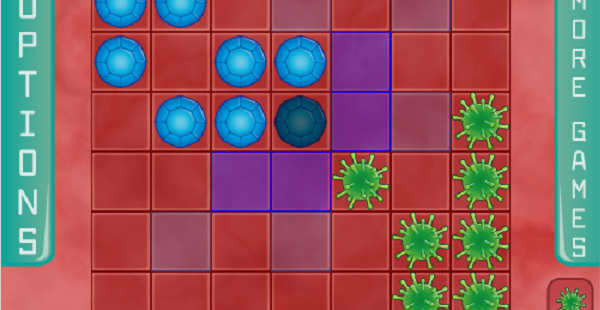
When you select an item in Infected, the cells are immediately highlighted where you can go.
There must be a good reason for changing established gameplay elements. For example, in the game Katamari Damacy , both joysticks are used for movement, and not as usual - one for movement, and the other for controlling the camera. At first it may be unusual, but the overall simplicity of the game means that this system works fine. Similarly, to win at Karoshi Suicide Salaryman , one must die by jumping on spikes. And even despite such an atypical goal, the player immediately understands what is required of him.
Games continue to evolve, but it is very important to understand that when changing any gameplay elements, players do not have to re-understand familiar things.
Continuous learning and experimentation
Note: if you do not provide detailed instructions, players will be forced to experiment. For example, every time you find a new item or equipment in a game from the Zelda series, you must independently figure out how it works. Instead of reading the long instructions for operating a new weapon, you end up in a closed room and must figure out how it works. Such tasks are not particularly difficult and are solved very quickly.
In fact, closed rooms are the same "cave beginners." Even in the middle of the game, they allow you to calmly figure out how a new item works. Having studied all the features of your new toy, you can again solve puzzles and fight monsters. Thus, you get so used to all types of weapons that at the end of the game you change them like gloves.
Education in Zelda deserves special mention - it continues throughout the game. With the exception of the last dungeon, the player constantly learns something new, and this is one of the greatest strengths of the Zelda series. The game does not rush to reveal all the cards and does not overload the player with tons of information at the very beginning.
Gradual learning is also effectively used in the game Plants vs Zombies. At each level, a new plant is opened, and the player learns to use it against a zombie army. The game is not overloaded and at the same time there is always something new and unknown in it. The ability to explore the characteristics of each new plant allows the player to choose the most effective fighters, depending on the situation, rather than using the same plants throughout the game.
Do not scare players
So, your game should not be boring or frightening. It would seem obvious, but you will be surprised how many games (including AAA-projects) ignore these truisms.
A good example is the mandatory registration in online games. If you want to attract a new player, do not force him to fill in the date of birth, e-mail address and a lot of other information - just give him a guest account. If he likes the game, most likely he will create a full account and provide all the data. In this sense, you can focus on the multiplayer online game Tagpro . To start playing, you only need to select a server and click the "Play as a guest" button.
In complex games, there is nothing bad, but it is important to remember that players cannot concentrate for a long time and are not ready to perceive large amounts of information. Try playing games like Crusader Kings, Europa Universalis, Dwarf Fortress or Civilization. If no one showed you how to play them, it can be very difficult to figure it out yourself. And despite the fact that these are awesome games, they will always be designed for a narrow circle of players - those who are interested in a long time to understand complex mechanics.
Conclusion
So that the player does not die of boredom, try to make playing training interesting. Games are very different, which means that the ideas described above need to be implemented in different ways. But only if you manage to capture the player’s attention for the first 5 minutes, can you keep him until the end of the game.
By and large, there are 3 types of gaming tutorials: non-interactive, interactive and passive. Let's take a look at each of them in turn.

Computer games are so multifaceted that instructions like "use arrows to move, and space to shoot" cannot be done here. Players need to explain, avoiding unduly rectilinear prompts, like “beware of sharp thorns”, how to interact with the outside world and overcome dangers.
In general, the tutorial I want to quickly get out of sight. The problem is that in the first few minutes the impression of the game is completely formed. In this regard, AAA-class games can afford more freedom, but developers of mobile and web applications should interest the player as early as possible, otherwise he will quickly jump off the hook. So, we face a difficult task - to create an exciting study without any burden, and even better - to make it part of the game.
')
Non-interactive training
Non-interactive gaming training is a relic of the past. Below is a screenshot from the game Infected, which we created with my team several years ago.

Training in the game Infected .
All training consists of a single picture. Looking back, I have to admit that we made a big mistake here. Seeing this screen, the players ran their eyes through the text and immediately pressed the "Start" button. As a result, most of them did not understand the rules.
According to the creator of the amazing game Plants vs. Zombies by George Fen , at any time of the game on the screen should be no more than eight words. This is because the majority of players cannot concentrate for a long time and are not ready to accept large amounts of information.
Non-interactive learning is not so hopeless, but almost always violates the eight-word rule. Its main disadvantage can be summarized as follows:
Too much information!
This is the most important rule for the design of gaming tutorials. The player must be well oriented in any situation. Seeing in front of him a list of two hundred combos and special attacks, he will remember only a couple of and will use them until the end of the game. Only if the training will be gradual, the player will be able to understand all the rules and master all the abilities.

We have already talked about this in the context of the use of game achievements in learning. Forcing the player to pass the level with the basic weapon, we will not achieve anything. But the opportunity to achieve an achievement for the fulfillment of this condition can be an incentive to try out new tactics and strategies (especially for experienced players).
Similarly, you can use the game rating system with scoring stars or points - "Losers" easier to pass levels, and lovers to overcome difficulties earn more points. This allows hardcore players to pass the levels at 100%, and casual players can enjoy the game without any difficulties.
The learning process in the game Super Meat Boy lasts as much as 6 levels. At first, the player learns to move and jump. At the second level - jump, starting from the walls. On the third - to run. Having dealt with the controls, he meets new obstacles: rotating blades, unstable platforms and steps.

The first level of the game Super Meat Boy. First you need to learn to walk and jump.
Losing on the first level Super Meat Boy is almost impossible. This technique in game design is called the “newcomers cave” —the player must first pass safe training levels before reaching the place where he can die. Thus, you can safely get acquainted with the game mechanics, without being distracted by enemies or expiring time on the timer.
To some extent, the “newcomers cave” is present in the Infected game - you can lose at the first level, but for this you need to try hard. The player gets a big starting advantage (2 times more elements than the opponent), and besides, the level of artificial intelligence is at zero. At high levels, the computer performs the calculated steps, but at the first level its actions are completely random. This means that even if a player does not understand the rules at all, his chances of winning are very high. (Some still managed to lose, but in general the gaming experience was much better compared to the original version, when at the very first level, players were faced with advanced artificial intelligence.)
There are several ways to implement the “novice cave”, but the most effective is interactive training, in which the player can perform only certain actions necessary to win. So, you can understand the rules right in the game, without risking to lose in the first minutes.
Interactive learning
Meet the game mechanics is much more interesting in practice. Instead of explaining the rules in words, it is better to let the player act on his own.

The first steps in the game Highrise Heroes.
A screenshot from the Highrise Heroes game perfectly demonstrates how to engage players in the learning process. Than just to show a picture illustrating the process of making a word, it is better to force the player to do it on their own, so that he will probably become familiar Until a player completes this basic task, he will not be able to go to the next level.
The only drawback of such training is that for players who are already familiar with the game, the mandatory passage of the tutorial can be boring. Opportunity to miss training will help to avoid this, but note that even those who play for the first time will not fail to take advantage of it. According to the creator of the game Steambirds, Andy Moore, having made the training mandatory, he managed to increase the retention rate of players from 60% to 95%.
Background training
Background training immediately immerses the player in the gameplay. There is a “cave for beginners”, but you can get out of it much faster and immediately plunge into the thick of things.
Consider this example:

The initial location of the game VVVVVV, where the player can understand the management.
At the very beginning of the game VVVVVV, a tooltip appears on how to move left and right. After that, the player is left with nothing but to go to the next room, where he learns to jump over obstacles. At this training ends. In principle, both stages would fit in the same room, but their separation helps the player better assimilate the information.
There is a very thin line between background and interactive tutorials. The main difference is that you can easily skip background training, and it will just fade into the background.

I saw her standing there - amazing flash game. Please note that you start playing even before the main menu appears.
We needed to use interactive or background training in Infected. It could be divided into 3 stages (movement, jumping and capturing elements of the opponent), and then it would be much easier for players to understand the gameplay. We understood this perfectly, but still decided not to bother with training and quickly finish the game.
Lack of learning
How to open the water? It is necessary to turn the handle of the crane to the right. How to tighten the nut? You need to turn the key clockwise. For these actions, no instructions are needed - we already understand their principle on an intuitive level. More precisely, we get this knowledge at an early age and consolidate it throughout life.
In games, everything is exactly the same. Experienced gamers subconsciously understand that you need to collect coins and earn points. But for beginners, this is not so obvious, so it is important for us to bring them up to date (although, even if you have never played platformers, you will understand that jumping into the fire is not the best idea).
The difference between “good” and “bad” should be clear from the first minutes, so that players do not have to learn from their mistakes, losing their lives. Shigeru Miyamoto once explained why coins are used in Mario:
"We have long thought about what any person would like to own, and could not think of anything better than money."
Plants and zombies in Plants vs. Zombies require no explanation. And it is so clear that zombies are moving slowly, and the plants are not moving at all. Instead of the hackneyed concept of “tower against soldiers”, the game offers an original idea, seasoned with an intuitive gameplay.

Agree, at first glance, it is clear what is happening on the screen.
Many players understand the general principles, so they do not need to explain everything. Let them figure it out on their own. If the player does not budge, give him a hint (“Move with the joystick”), but note that in most cases the players themselves are trying to execute the basic commands. Basic mechanics are usually universal, so it can be assumed that they are already familiar to the players, but at the same time changing them can be very dangerous.
Some new game designers believe that the rules are invented for wimps, and are often neglected by them. In the past, games in the RTS genre have suffered greatly from this misconception. Modern strategies use a fairly standardized control system (the left mouse button for selecting and the right one for moving or attacking), but in older games the control varied greatly - the left and right buttons performed different actions, and several commands could be attached to one button. Playing old strategies today can be very problematic, because we have become accustomed to a different management system.
We can say that Infected was saved by intuitive control. Even if a player misses training, when an element is selected, the cells are immediately highlighted, which you can resemble. Such visual highlighting hints that the player is doing everything right, and encourages independent research of game mechanics. In the initial versions, the backlight was absent, but later we made sure that this small graphic addition makes the gameplay much more accessible.

When you select an item in Infected, the cells are immediately highlighted where you can go.
There must be a good reason for changing established gameplay elements. For example, in the game Katamari Damacy , both joysticks are used for movement, and not as usual - one for movement, and the other for controlling the camera. At first it may be unusual, but the overall simplicity of the game means that this system works fine. Similarly, to win at Karoshi Suicide Salaryman , one must die by jumping on spikes. And even despite such an atypical goal, the player immediately understands what is required of him.
Games continue to evolve, but it is very important to understand that when changing any gameplay elements, players do not have to re-understand familiar things.
Continuous learning and experimentation
Note: if you do not provide detailed instructions, players will be forced to experiment. For example, every time you find a new item or equipment in a game from the Zelda series, you must independently figure out how it works. Instead of reading the long instructions for operating a new weapon, you end up in a closed room and must figure out how it works. Such tasks are not particularly difficult and are solved very quickly.
In fact, closed rooms are the same "cave beginners." Even in the middle of the game, they allow you to calmly figure out how a new item works. Having studied all the features of your new toy, you can again solve puzzles and fight monsters. Thus, you get so used to all types of weapons that at the end of the game you change them like gloves.
Education in Zelda deserves special mention - it continues throughout the game. With the exception of the last dungeon, the player constantly learns something new, and this is one of the greatest strengths of the Zelda series. The game does not rush to reveal all the cards and does not overload the player with tons of information at the very beginning.
Gradual learning is also effectively used in the game Plants vs Zombies. At each level, a new plant is opened, and the player learns to use it against a zombie army. The game is not overloaded and at the same time there is always something new and unknown in it. The ability to explore the characteristics of each new plant allows the player to choose the most effective fighters, depending on the situation, rather than using the same plants throughout the game.
Do not scare players
So, your game should not be boring or frightening. It would seem obvious, but you will be surprised how many games (including AAA-projects) ignore these truisms.
A good example is the mandatory registration in online games. If you want to attract a new player, do not force him to fill in the date of birth, e-mail address and a lot of other information - just give him a guest account. If he likes the game, most likely he will create a full account and provide all the data. In this sense, you can focus on the multiplayer online game Tagpro . To start playing, you only need to select a server and click the "Play as a guest" button.
In complex games, there is nothing bad, but it is important to remember that players cannot concentrate for a long time and are not ready to perceive large amounts of information. Try playing games like Crusader Kings, Europa Universalis, Dwarf Fortress or Civilization. If no one showed you how to play them, it can be very difficult to figure it out yourself. And despite the fact that these are awesome games, they will always be designed for a narrow circle of players - those who are interested in a long time to understand complex mechanics.
Conclusion
So that the player does not die of boredom, try to make playing training interesting. Games are very different, which means that the ideas described above need to be implemented in different ways. But only if you manage to capture the player’s attention for the first 5 minutes, can you keep him until the end of the game.
Source: https://habr.com/ru/post/279081/
All Articles